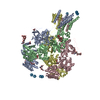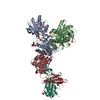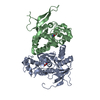[English] 日本語
 Yorodumi
Yorodumi- EMDB-9163: Triheteromeric NMDA receptor GluN1/GluN2A/GluN2A* Extracellular D... -
+ Open data
Open data
- Basic information
Basic information
| Entry | Database: EMDB / ID: EMD-9163 | |||||||||
|---|---|---|---|---|---|---|---|---|---|---|
| Title | Triheteromeric NMDA receptor GluN1/GluN2A/GluN2A* Extracellular Domain in the '2-Knuckle-Asymmetric' conformation, in complex with glycine and glutamate, in the presence of 1 micromolar zinc chloride, and at pH 7.4 | |||||||||
 Map data Map data | Triheteromeric NMDA receptor GluN1/GluN2A/GluN2A* Extracellular Domain in the '2-Knuckle-Asymmetric' conformation, in complex with glycine and glutamate, in the presence of 1 micromolar zinc chloride, and at pH 7.4 | |||||||||
 Sample Sample |
| |||||||||
 Keywords Keywords | Ligand-gated Ion Channel / NMDA Receptor / ionotropic Glutamate Receptors / membrane protein / TRANSPORT PROTEIN | |||||||||
| Function / homology |  Function and homology information Function and homology informationneurotransmitter receptor transport, plasma membrane to endosome / regulation of response to alcohol / response to ammonium ion / receptor recycling / response to hydrogen sulfide / positive regulation of inhibitory postsynaptic potential / directional locomotion / response to environmental enrichment / response to other organism / response to methylmercury ...neurotransmitter receptor transport, plasma membrane to endosome / regulation of response to alcohol / response to ammonium ion / receptor recycling / response to hydrogen sulfide / positive regulation of inhibitory postsynaptic potential / directional locomotion / response to environmental enrichment / response to other organism / response to methylmercury / regulation of ARF protein signal transduction / pons maturation / regulation of cell communication / positive regulation of Schwann cell migration / EPHB-mediated forward signaling / Assembly and cell surface presentation of NMDA receptors / serotonin metabolic process / olfactory learning / response to carbohydrate / dendritic branch / cellular response to dsRNA / conditioned taste aversion / cellular response to lipid / regulation of respiratory gaseous exchange / cellular response to magnesium ion / protein localization to postsynaptic membrane / conditioned place preference / propylene metabolic process / response to glycine / sleep / locomotion / dendritic spine organization / response to manganese ion / regulation of monoatomic cation transmembrane transport / voltage-gated monoatomic cation channel activity / Synaptic adhesion-like molecules / RAF/MAP kinase cascade / NMDA glutamate receptor activity / regulation of NMDA receptor activity / parallel fiber to Purkinje cell synapse / NMDA selective glutamate receptor complex / response to morphine / cellular response to zinc ion / calcium ion transmembrane import into cytosol / glutamate receptor signaling pathway / glutamate binding / neuromuscular process / protein heterotetramerization / positive regulation of calcium ion transport into cytosol / positive regulation of reactive oxygen species biosynthetic process / regulation of synapse assembly / glycine binding / regulation of axonogenesis / regulation of dendrite morphogenesis / male mating behavior / spinal cord development / action potential / suckling behavior / dopamine metabolic process / startle response / response to amine / regulation of neuronal synaptic plasticity / monoatomic cation transmembrane transport / modulation of excitatory postsynaptic potential / response to lithium ion / associative learning / monoatomic cation transport / social behavior / excitatory synapse / ligand-gated monoatomic ion channel activity / positive regulation of excitatory postsynaptic potential / regulation of postsynaptic membrane potential / cellular response to glycine / neuron development / postsynaptic density, intracellular component / positive regulation of dendritic spine maintenance / response to light stimulus / positive regulation of protein targeting to membrane / multicellular organismal response to stress / Unblocking of NMDA receptors, glutamate binding and activation / cellular response to manganese ion / phosphatase binding / glutamate receptor binding / long-term memory / regulation of neuron apoptotic process / monoatomic cation channel activity / prepulse inhibition / calcium ion homeostasis / synaptic cleft / glutamate-gated receptor activity / cell adhesion molecule binding / response to fungicide / glutamate-gated calcium ion channel activity / presynaptic active zone membrane / dendrite membrane / ligand-gated monoatomic ion channel activity involved in regulation of presynaptic membrane potential / sensory perception of pain / response to amphetamine / ionotropic glutamate receptor signaling pathway / protein tyrosine kinase binding Similarity search - Function | |||||||||
| Biological species |  | |||||||||
| Method | single particle reconstruction / cryo EM / Resolution: 4.71 Å | |||||||||
 Authors Authors | Jalali-Yazdi F / Chowdhury S | |||||||||
| Funding support |  United States, 2 items United States, 2 items
| |||||||||
 Citation Citation |  Journal: Cell / Year: 2018 Journal: Cell / Year: 2018Title: Mechanisms for Zinc and Proton Inhibition of the GluN1/GluN2A NMDA Receptor. Authors: Farzad Jalali-Yazdi / Sandipan Chowdhury / Craig Yoshioka / Eric Gouaux /  Abstract: N-methyl-D-aspartate receptors (NMDARs) play essential roles in memory formation, neuronal plasticity, and brain development, with their dysfunction linked to a range of disorders from ischemia to ...N-methyl-D-aspartate receptors (NMDARs) play essential roles in memory formation, neuronal plasticity, and brain development, with their dysfunction linked to a range of disorders from ischemia to schizophrenia. Zinc and pH are physiological allosteric modulators of NMDARs, with GluN2A-containing receptors inhibited by nanomolar concentrations of divalent zinc and by excursions to low pH. Despite the widespread importance of zinc and proton modulation of NMDARs, the molecular mechanism by which these ions modulate receptor activity has proven elusive. Here, we use cryoelectron microscopy to elucidate the structure of the GluN1/GluN2A NMDAR in a large ensemble of conformations under a range of physiologically relevant zinc and proton concentrations. We show how zinc binding to the amino terminal domain elicits structural changes that are transduced though the ligand-binding domain and result in constriction of the ion channel gate. | |||||||||
| History |
|
- Structure visualization
Structure visualization
| Movie |
 Movie viewer Movie viewer |
|---|---|
| Structure viewer | EM map:  SurfView SurfView Molmil Molmil Jmol/JSmol Jmol/JSmol |
| Supplemental images |
- Downloads & links
Downloads & links
-EMDB archive
| Map data |  emd_9163.map.gz emd_9163.map.gz | 59.4 MB |  EMDB map data format EMDB map data format | |
|---|---|---|---|---|
| Header (meta data) |  emd-9163-v30.xml emd-9163-v30.xml emd-9163.xml emd-9163.xml | 28.1 KB 28.1 KB | Display Display |  EMDB header EMDB header |
| Images |  emd_9163.png emd_9163.png | 174.6 KB | ||
| Masks |  emd_9163_msk_1.map emd_9163_msk_1.map | 64 MB |  Mask map Mask map | |
| Filedesc metadata |  emd-9163.cif.gz emd-9163.cif.gz | 7.8 KB | ||
| Others |  emd_9163_half_map_1.map.gz emd_9163_half_map_1.map.gz emd_9163_half_map_2.map.gz emd_9163_half_map_2.map.gz | 13.2 MB 13.2 MB | ||
| Archive directory |  http://ftp.pdbj.org/pub/emdb/structures/EMD-9163 http://ftp.pdbj.org/pub/emdb/structures/EMD-9163 ftp://ftp.pdbj.org/pub/emdb/structures/EMD-9163 ftp://ftp.pdbj.org/pub/emdb/structures/EMD-9163 | HTTPS FTP |
-Validation report
| Summary document |  emd_9163_validation.pdf.gz emd_9163_validation.pdf.gz | 941.5 KB | Display |  EMDB validaton report EMDB validaton report |
|---|---|---|---|---|
| Full document |  emd_9163_full_validation.pdf.gz emd_9163_full_validation.pdf.gz | 941.1 KB | Display | |
| Data in XML |  emd_9163_validation.xml.gz emd_9163_validation.xml.gz | 12.9 KB | Display | |
| Data in CIF |  emd_9163_validation.cif.gz emd_9163_validation.cif.gz | 14.7 KB | Display | |
| Arichive directory |  https://ftp.pdbj.org/pub/emdb/validation_reports/EMD-9163 https://ftp.pdbj.org/pub/emdb/validation_reports/EMD-9163 ftp://ftp.pdbj.org/pub/emdb/validation_reports/EMD-9163 ftp://ftp.pdbj.org/pub/emdb/validation_reports/EMD-9163 | HTTPS FTP |
-Related structure data
| Related structure data |  6mmvMC  9147C  9148C  9149C  9150C  9151C  9152C  9153C  9154C  9155C  9156C  9157C  9158C  9159C  9160C  9161C  9162C  9164C  9165C  6mm9C  6mmaC  6mmbC  6mmgC  6mmhC  6mmiC  6mmjC  6mmkC  6mmlC  6mmmC  6mmnC  6mmpC  6mmrC  6mmsC  6mmtC  6mmuC  6mmwC  6mmxC C: citing same article ( M: atomic model generated by this map |
|---|---|
| Similar structure data |
- Links
Links
| EMDB pages |  EMDB (EBI/PDBe) / EMDB (EBI/PDBe) /  EMDataResource EMDataResource |
|---|---|
| Related items in Molecule of the Month |
- Map
Map
| File |  Download / File: emd_9163.map.gz / Format: CCP4 / Size: 64 MB / Type: IMAGE STORED AS FLOATING POINT NUMBER (4 BYTES) Download / File: emd_9163.map.gz / Format: CCP4 / Size: 64 MB / Type: IMAGE STORED AS FLOATING POINT NUMBER (4 BYTES) | ||||||||||||||||||||||||||||||||||||||||||||||||||||||||||||||||||||
|---|---|---|---|---|---|---|---|---|---|---|---|---|---|---|---|---|---|---|---|---|---|---|---|---|---|---|---|---|---|---|---|---|---|---|---|---|---|---|---|---|---|---|---|---|---|---|---|---|---|---|---|---|---|---|---|---|---|---|---|---|---|---|---|---|---|---|---|---|---|
| Annotation | Triheteromeric NMDA receptor GluN1/GluN2A/GluN2A* Extracellular Domain in the '2-Knuckle-Asymmetric' conformation, in complex with glycine and glutamate, in the presence of 1 micromolar zinc chloride, and at pH 7.4 | ||||||||||||||||||||||||||||||||||||||||||||||||||||||||||||||||||||
| Projections & slices | Image control
Images are generated by Spider. | ||||||||||||||||||||||||||||||||||||||||||||||||||||||||||||||||||||
| Voxel size | X=Y=Z: 1.71 Å | ||||||||||||||||||||||||||||||||||||||||||||||||||||||||||||||||||||
| Density |
| ||||||||||||||||||||||||||||||||||||||||||||||||||||||||||||||||||||
| Symmetry | Space group: 1 | ||||||||||||||||||||||||||||||||||||||||||||||||||||||||||||||||||||
| Details | EMDB XML:
CCP4 map header:
| ||||||||||||||||||||||||||||||||||||||||||||||||||||||||||||||||||||
-Supplemental data
-Mask #1
| File |  emd_9163_msk_1.map emd_9163_msk_1.map | ||||||||||||
|---|---|---|---|---|---|---|---|---|---|---|---|---|---|
| Projections & Slices |
| ||||||||||||
| Density Histograms |
-Half map: Half-maps used for FSC calculations
| File | emd_9163_half_map_1.map | ||||||||||||
|---|---|---|---|---|---|---|---|---|---|---|---|---|---|
| Annotation | Half-maps used for FSC calculations | ||||||||||||
| Projections & Slices |
| ||||||||||||
| Density Histograms |
-Half map: Half-maps used for FSC calculations
| File | emd_9163_half_map_2.map | ||||||||||||
|---|---|---|---|---|---|---|---|---|---|---|---|---|---|
| Annotation | Half-maps used for FSC calculations | ||||||||||||
| Projections & Slices |
| ||||||||||||
| Density Histograms |
- Sample components
Sample components
-Entire : Triheteromeric NMDA receptor GluN1/GluN2A/GluN2A* Extracellular D...
| Entire | Name: Triheteromeric NMDA receptor GluN1/GluN2A/GluN2A* Extracellular Domain in the '2-Knuckle-Asymmetric' conformation, in complex with glycine and glutamate, in the presence of 1 micromolar zinc chloride, and at pH 7.4 |
|---|---|
| Components |
|
-Supramolecule #1: Triheteromeric NMDA receptor GluN1/GluN2A/GluN2A* Extracellular D...
| Supramolecule | Name: Triheteromeric NMDA receptor GluN1/GluN2A/GluN2A* Extracellular Domain in the '2-Knuckle-Asymmetric' conformation, in complex with glycine and glutamate, in the presence of 1 micromolar zinc chloride, and at pH 7.4 type: complex / ID: 1 / Parent: 0 / Macromolecule list: #1-#3 Details: Sample was heterologously expressed in TSA-201 cells, detergent solubilized, and affinity purified serially to obtain the triheteromeric receptor |
|---|---|
| Source (natural) | Organism:  |
| Molecular weight | Theoretical: 500 KDa |
-Macromolecule #1: Glutamate receptor ionotropic, NMDA 1
| Macromolecule | Name: Glutamate receptor ionotropic, NMDA 1 / type: protein_or_peptide / ID: 1 / Number of copies: 2 / Enantiomer: LEVO |
|---|---|
| Source (natural) | Organism:  |
| Molecular weight | Theoretical: 89.853656 KDa |
| Recombinant expression | Organism:  Homo sapiens (human) Homo sapiens (human) |
| Sequence | String: MSTMHLLTFA LLFSCSFARA ACDPKIVNIG AVLSTRKHEQ MFREAVNQAN KRHGSWKIQL NATSVTHKPN AIQMALSVCE DLISSQVYA ILVSHPPTPN DHFTPTPVSY TAGFYRIPVL GLTTRMSIYS DKSIHLSFLR TVPPYSHQSS VWFEMMRVYN W NHIILLVS ...String: MSTMHLLTFA LLFSCSFARA ACDPKIVNIG AVLSTRKHEQ MFREAVNQAN KRHGSWKIQL NATSVTHKPN AIQMALSVCE DLISSQVYA ILVSHPPTPN DHFTPTPVSY TAGFYRIPVL GLTTRMSIYS DKSIHLSFLR TVPPYSHQSS VWFEMMRVYN W NHIILLVS DDHEGRAAQK RLETLLEERE SKAEKVLQFD PGTKNVTALL MEARELEARV IILSASEDDA ATVYRAAAML NM TGSGYVW LVGEREISGN ALRYAPDGII GLQLINGKNE SAHISDAVGV VAQAVHELLE KENITDPPRG CVGNTNIWKT GPL FKRVLM SSKYADGVTG RVEFNEDGDR KFANYSIMNL QNRKLVQVGI YNGTHVIPND RKIIWPGGET EKPRGYQMST RLKI VTIHQ EPFVYVKPTM SDGTCKEEFT VNGDPVKKVI CTGPNDTSPG SPRHTVPQCC YGFCIDLLIK LARTMNFTYE VHLVA DGKF GTQERVNNSN KKEWNGMMGE LLSGQADMIV APLTINNERA QYIEFSKPFK YQGLTILVKK EIPRSTLDSF MQPFQS TLW LLVGLSVHVV AVMLYLLDRF SPFGRFKVNS EEEEEDALTL SSAMWFSWGV LLNSGIGEGA PRSFSARILG MVWAGFA MI IVASYTANLA AFLVLDRPEE RITGINDPRL RNPSDKFIYA TVKQSSVDIY FRRQVELSTM YRHMEKHNYE SAAEAIQA V RDNKLHAFIW DSAVLEFEAS QKCDLVTTGE LFFRSGFGIG MRKDSPWKQN VSLSILKSHE NGFMEDLDKT WVRYQE UniProtKB: Glutamate receptor ionotropic, NMDA 1 |
-Macromolecule #2: Glutamate receptor ionotropic, NMDA 2A
| Macromolecule | Name: Glutamate receptor ionotropic, NMDA 2A / type: protein_or_peptide / ID: 2 / Number of copies: 1 / Enantiomer: LEVO |
|---|---|
| Source (natural) | Organism:  |
| Molecular weight | Theoretical: 89.580523 KDa |
| Recombinant expression | Organism:  Homo sapiens (human) Homo sapiens (human) |
| Sequence | String: MGRLGYWTLL VLPALLVWRD PAQNAAAEKG PPALNIAVLL GHSHDVTERE LRNLWGPEQA TGLPLDVNVV ALLMNRTDPK SLITHVCDL MSGARIHGLV FGDDTDQEAV AQMLDFISSQ TFIPILGIHG GASMIMADKD PTSTFFQFGA SIQQQATVML K IMQDYDWH ...String: MGRLGYWTLL VLPALLVWRD PAQNAAAEKG PPALNIAVLL GHSHDVTERE LRNLWGPEQA TGLPLDVNVV ALLMNRTDPK SLITHVCDL MSGARIHGLV FGDDTDQEAV AQMLDFISSQ TFIPILGIHG GASMIMADKD PTSTFFQFGA SIQQQATVML K IMQDYDWH VFSLVTTIFP GYRDFISFIK TTVDNSFVGW DMQNVITLDT SFEDAKTQVQ LKKIHSSVIL LYCSKDEAVL IL SEARSLG LTGYDFFWIV PSLVSGNTEL IPKEFPSGLI SVSYDDWDYS LEARVRDGLG ILTTAASSML EKFSYIPEAK ASC YGQAEK PETPLHTLHQ FMVNVTWDGK DLSFTEEGYQ VHPRLVVIVL NKDREWEKVG KWENQTLSLR HAVWPRYKSF SDCE PDDNH LSIVTLEEAP FVIVEDIDPL TETCVRNTVP CRKFVKINNS TNEGMNVKKC CKGFCIDILK KLSRTVKFTY DLYLV TNGK HGKKVNNVWN GMIGEVVYQR AVMAVGSLTI NEERSEVVDF SVPFVETGIS VMVSRSNGTV SPSAFLEPFS ASVWVM MFV MLLIVSAIAV FVFEYFSPVG YNRNLAKGKA PHGPSFTIGK AIWLLWGLVF NNSVPVQNPK GTTSKIMVSV WAFFAVI FL ASYTANLAAF MIQEEFVDQV TGLSDKKFQR PHDYSPPFRF GTVPNGSTER NIRNNYPYMH QYMTRFNQRG VEDALVSL K TGKLDAFIYD AAVLNYKAGR DEGCKLVTIG SGYIFATTGY GIALQKGSPW KRQIDLALLQ FVGDGEMEEL ETLWLTGIC UniProtKB: Glutamate receptor ionotropic, NMDA 2A |
-Macromolecule #3: Glutamate receptor ionotropic, NMDA 2A
| Macromolecule | Name: Glutamate receptor ionotropic, NMDA 2A / type: protein_or_peptide / ID: 3 / Number of copies: 1 / Enantiomer: LEVO |
|---|---|
| Source (natural) | Organism:  |
| Molecular weight | Theoretical: 89.543477 KDa |
| Recombinant expression | Organism:  Homo sapiens (human) Homo sapiens (human) |
| Sequence | String: MGRLGYWTLL VLPALLVWRD PAQNAAAEKG PPALNIAVLL GHSHDVTERE LRNLWGPEQA TGLPLDVNVV ALLMNRTDPK SLITHVCDL MSGARIHGLV FGDDTDQEAV AQMLDFISSQ TFIPILGISG GASMIMADKD PTSTFFQFGA SIQQQATVML K IMQDYDWH ...String: MGRLGYWTLL VLPALLVWRD PAQNAAAEKG PPALNIAVLL GHSHDVTERE LRNLWGPEQA TGLPLDVNVV ALLMNRTDPK SLITHVCDL MSGARIHGLV FGDDTDQEAV AQMLDFISSQ TFIPILGISG GASMIMADKD PTSTFFQFGA SIQQQATVML K IMQDYDWH VFSLVTTIFP GYRDFISFIK TTVDNSFVGW DMQNVITLDT SFEDAKTQVQ LKKIHSSVIL LYCSKDEAVL IL SEARSLG LTGYDFFWIV PSLVSGNTEL IPKEFPSGLI SVSYDDWDYS LEARVRDGLG ILTTAASSML EKFSYIPEAK ASC YGQAEK PETPLHTLHQ FMVNVTWDGK DLSFTEEGYQ VHPRLVVIVL NKDREWEKVG KWENQTLSLR HAVWPRYKSF SDCE PDDNH LSIVTLEEAP FVIVEDIDPL TETCVRNTVP CRKFVKINNS TNEGMNVKKC CKGFCIDILK KLSRTVKFTY DLYLV TNGK HGKKVNNVWN GMIGEVVYQR AVMAVGSLTI NEERSEVVDF SVPFVETGIS VMVSRSNGTV SPSAFLEPFS ASVWVM MFV MLLIVSAIAV FVFEYFSPVG YNRNLAKGKA PHGPSFTIGK AIWLLWGLVF NNSVPVQNPK GTTSKIMVSV WAFFAVI FL ASYTANLAAF MIQEEFVDQV TGLSDKKFQR PHDYSPPFRF GTVPQGSTER NIRNNYPYMH QYMTRFNQRG VEDALVSL K TGKLDAFIYD AAVLNYKAGR DEGCKLVTIG SGYIFATTGY GIALQKGSPW KRQIDLALLQ FVGDGEMEEL ETLWLTGIC UniProtKB: Glutamate receptor ionotropic, NMDA 2A |
-Macromolecule #5: 2-acetamido-2-deoxy-beta-D-glucopyranose
| Macromolecule | Name: 2-acetamido-2-deoxy-beta-D-glucopyranose / type: ligand / ID: 5 / Number of copies: 26 / Formula: NAG |
|---|---|
| Molecular weight | Theoretical: 221.208 Da |
| Chemical component information |  ChemComp-NAG: |
-Experimental details
-Structure determination
| Method | cryo EM |
|---|---|
 Processing Processing | single particle reconstruction |
| Aggregation state | particle |
- Sample preparation
Sample preparation
| Concentration | 4.0 mg/mL | |||||||||||||||
|---|---|---|---|---|---|---|---|---|---|---|---|---|---|---|---|---|
| Buffer | pH: 7.4 Component:
| |||||||||||||||
| Grid | Model: Quantifoil R1.2/1.3 / Material: GOLD / Mesh: 300 / Support film - Material: CARBON / Support film - topology: HOLEY / Pretreatment - Type: GLOW DISCHARGE / Pretreatment - Time: 60 sec. / Pretreatment - Atmosphere: AIR | |||||||||||||||
| Vitrification | Cryogen name: ETHANE / Chamber humidity: 100 % / Chamber temperature: 291 K / Instrument: FEI VITROBOT MARK IV Details: Sample was blotted for 3 seconds at blot force 1.. | |||||||||||||||
| Details | This sample was monodisperse |
- Electron microscopy
Electron microscopy
| Microscope | FEI TITAN KRIOS |
|---|---|
| Image recording | Film or detector model: GATAN K2 BASE (4k x 4k) / Number grids imaged: 1 / Number real images: 1891 / Average exposure time: 22.0 sec. / Average electron dose: 52.0 e/Å2 |
| Electron beam | Acceleration voltage: 300 kV / Electron source:  FIELD EMISSION GUN FIELD EMISSION GUN |
| Electron optics | Illumination mode: FLOOD BEAM / Imaging mode: BRIGHT FIELD / Cs: 2.7 mm |
| Experimental equipment |  Model: Titan Krios / Image courtesy: FEI Company |
+ Image processing
Image processing
-Atomic model buiding 1
| Initial model |
| ||||||||||
|---|---|---|---|---|---|---|---|---|---|---|---|
| Refinement | Protocol: RIGID BODY FIT | ||||||||||
| Output model |  PDB-6mmv: |
 Movie
Movie Controller
Controller


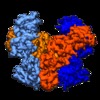

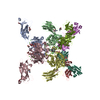







 Z (Sec.)
Z (Sec.) Y (Row.)
Y (Row.) X (Col.)
X (Col.)













































